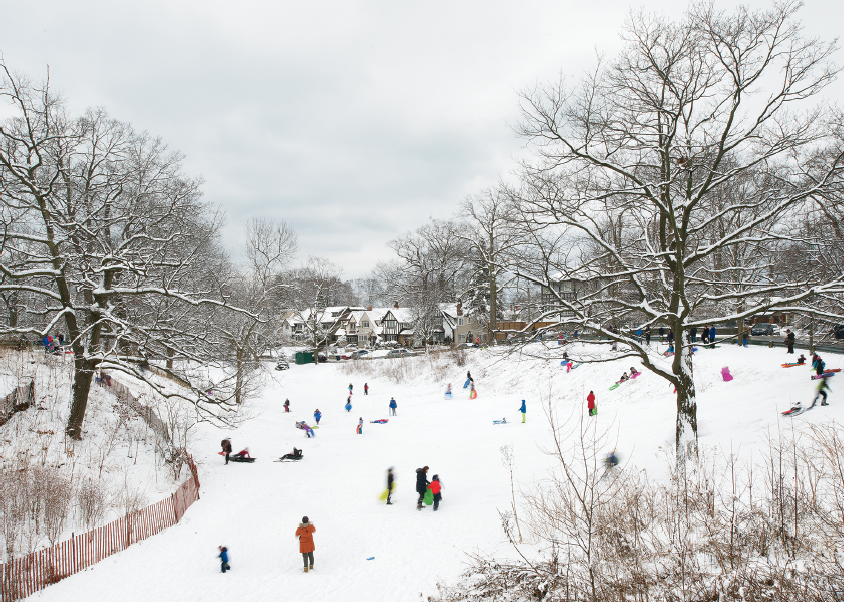“An Enduring Wilderness: Toronto’s Natural Parklands”
by Robert Burley

Robert Burley, Glen Stewart Ravine, 2016. Courtesy ECW Press.
Moving his focus from Disappearance of Darkness: Photography at the End of the Analog Era, 2012, where he documented the destruction and end of the analogue factories, to the green spaces of Toronto, Robert Burley’s new book project focuses on Toronto’s natural parklands. With An Enduring Wilderness: Toronto’s Natural Parklands (ECW Press, 2017), there is a fascinating collaboration, less a conventional photo book than a way of looking at the largely unseen green mosaic of urban Toronto. Burley spent 10 years travelling the globe, looking at the destruction of film-based photography institutions, many of which had stood for over a century: Kodak, Polaroid, Agfa Gaevert, Ilford and others. His most recent project explores the urban green spaces, river valleys and nature within the city of Toronto.
The last time Burley explored urban green spaces was a project called Viewing Olmsted, 1996, for which he, along with fellow photographers Lee Friedlander and Geoffrey James, was commissioned by Phyllis Lambert and the Canadian Centre for Architecture. Robert Burley’s colour photos for that project explored the natural aesthetics of Mount Royal, which had been designed by landscape designer Frederick Law Olmsted of Central Park, New York, renown.
In this current book the spaces, zones, ravines and valleys photographed by Burley over four years are the pre-settlement, non-managed green spaces of Toronto. As Robert Fulford once wrote, ravines are at “the heart of the city’s emotional geography.” As this book makes more than evident, Toronto’s older, less orchestrated nature areas, more than the designed public parks, still have an edge of wildness to them. The book’s various essays are key. They offer insights and another medium with which to envision what urban nature is, can be or is remembered as. Leanne Betasamosake Simpson, a writer and musician, presents an Amerindian perspective on the canalized concrete of Black Creek, reminding us of how this waterway was once a conduit for travel and its waters were pure and clean. Michael Mitchell explores the Humber River, with his childhood experiences there being a key point of remembrance and contact. Lisa York-Richler focuses on the Don Valley, a place in which she has created a project for literary readings. Canada’s current poet laureate, George Elliott Clarke, likewise explores and delves into Highland Creek, while Wayne Reeves, chief curator of the City of Toronto’s art collection, explores the natural history of Toronto and brings an historical perspective on the ravines, and there is a fine and lyric essay by Anne Michaels.
We see a series of images of the Scarborough Bluffs, the Bloor Street Viaduct (whose construction was featured in Michael Ondaatje’s novel In the Skin of the Lion), of the Humber River marshes with high-rise apartments in the distance, of a bike rider in Eaton Park resting on a silent trail, and yet another image of the Rouge and Little Rouge rivers. Burley photographs in the scale of life. There is no aggrandizement or denaturalization of what he brings to the garden. His aesthetic is comprehensive and his visuality is oriented to the overview, without the shock factor.
Burley’s lens builds aesthetic and visual continuities between the nature that is there and the city of which it is a part. The photos and essays in An Enduring Wilderness interweave the cultural and natural, fusing them into Toronto’s green urban spaces. Much was planned, but, equally, recognition of what is actually there—the rivers, ravines, the verdant spaces—was necessary, and this is what Burley has done with an all-seeing eye for how nature, a potential cathartic and healing presence, exists on the edge of the urban. He accomplishes his goal, and visually maps out the culture / nature dialogue with an interesting combination of text and image. The dialogue is about the physicality of things, those places we do not see, so anaesthetized are we by cell phones, computers and the digital universe that parallels all of this.
Talking about the Toronto project, Burley said, “This book is an exploration of Toronto’s extensive natural park system, but I feel it also addresses a human need created by a nature-deficit we are all collectively experiencing today. When my photography is combined with the physical act of walking, I can eliminate distractions and see my surroundings on a very personallevel. I think this solitary, mindful and subjective experience has always been a part of picturing the landscape, whether it be with oil paint, silver salts or data.”
Robert Burley’s engagement and catalyzing direction enable a series of perspectives on green spaces in Toronto, and orchestrate a potential aesthetic that recaptures the place these spaces once held in Toronto. ❚
An Enduring Wilderness: Toronto’s Natural Parklands by Robert Burley, ECW Press, 264 pages, hardcover, $41.99.
John K Grande is a poet, art writer and curator. He will be curating “Richard Watts: Canoe People” at the Tom Thomson Gallery in Owen Sound in 2018.

